
An ecosystem is a system that environments and their organisms form through their interaction. The biotic and abiotic components are linked together through nutrient cycles and energy flows.

The carbon cycle is that part of the biogeochemical cycle by which carbon is exchanged among the biosphere, pedosphere, geosphere, hydrosphere, and atmosphere of Earth. Other major biogeochemical cycles include the nitrogen cycle and the water cycle. Carbon is the main component of biological compounds as well as a major component of many minerals such as limestone. The carbon cycle comprises a sequence of events that are key to making Earth capable of sustaining life. It describes the movement of carbon as it is recycled and reused throughout the biosphere, as well as long-term processes of carbon sequestration (storage) to and release from carbon sinks.
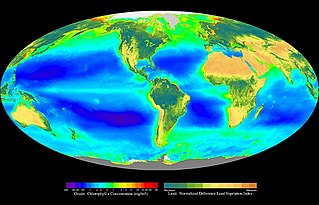
In ecology, primary production is the synthesis of organic compounds from atmospheric or aqueous carbon dioxide. It principally occurs through the process of photosynthesis, which uses light as its source of energy, but it also occurs through chemosynthesis, which uses the oxidation or reduction of inorganic chemical compounds as its source of energy. Almost all life on Earth relies directly or indirectly on primary production. The organisms responsible for primary production are known as primary producers or autotrophs, and form the base of the food chain. In terrestrial ecoregions, these are mainly plants, while in aquatic ecoregions algae predominate in this role. Ecologists distinguish primary production as either net or gross, the former accounting for losses to processes such as cellular respiration, the latter not.

A biogeochemical cycle, or more generally a cycle of matter, is the movement and transformation of chemical elements and compounds between living organisms, the atmosphere, and the Earth's crust. Major biogeochemical cycles include the carbon cycle, the nitrogen cycle and the water cycle. In each cycle, the chemical element or molecule is transformed and cycled by living organisms and through various geological forms and reservoirs, including the atmosphere, the soil and the oceans. It can be thought of as the pathway by which a chemical substance cycles the biotic compartment and the abiotic compartments of Earth. The biotic compartment is the biosphere and the abiotic compartments are the atmosphere, lithosphere and hydrosphere.

Biogeochemistry is the scientific discipline that involves the study of the chemical, physical, geological, and biological processes and reactions that govern the composition of the natural environment. In particular, biogeochemistry is the study of biogeochemical cycles, the cycles of chemical elements such as carbon and nitrogen, and their interactions with and incorporation into living things transported through earth scale biological systems in space and time. The field focuses on chemical cycles which are either driven by or influence biological activity. Particular emphasis is placed on the study of carbon, nitrogen, oxygen, sulfur, iron, and phosphorus cycles. Biogeochemistry is a systems science closely related to systems ecology.
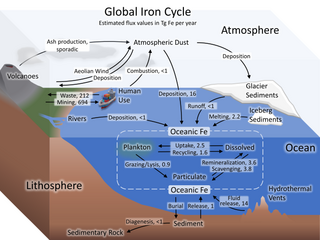
The iron cycle (Fe) is the biogeochemical cycle of iron through the atmosphere, hydrosphere, biosphere and lithosphere. While Fe is highly abundant in the Earth's crust, it is less common in oxygenated surface waters. Iron is a key micronutrient in primary productivity, and a limiting nutrient in the Southern ocean, eastern equatorial Pacific, and the subarctic Pacific referred to as High-Nutrient, Low-Chlorophyll (HNLC) regions of the ocean.
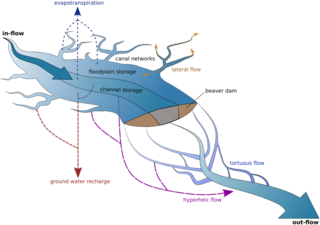
Ecohydrology is an interdisciplinary scientific field studying the interactions between water and ecological systems. It is considered a sub discipline of hydrology, with an ecological focus. These interactions may take place within water bodies, such as rivers and lakes, or on land, in forests, deserts, and other terrestrial ecosystems. Areas of research in ecohydrology include transpiration and plant water use, adaption of organisms to their water environment, influence of vegetation and benthic plants on stream flow and function, and feedbacks between ecological processes, the soil carbon sponge and the hydrological cycle.

FLUXNET is a global network of micrometeorological tower sites that use eddy covariance methods to measure the exchanges of carbon dioxide, water vapor, and energy between the biosphere and atmosphere. FLUXNET is a global 'network of regional networks' that serves to provide an infrastructure to compile, archive and distribute data for the scientific community. The most recent FLUXNET data product, FLUXNET2015, is hosted by the Lawrence Berkeley National Laboratory (USA) and is publicly available for download. Currently there are over 1000 active and historic flux measurement sites.
IBIS-2 is the version 2 of the land-surface model Integrated Biosphere Simulator (IBIS), which includes several major improvements and additions to the prototype model developed by Foley et al. [1996]. IBIS was designed to explicitly link land surface and hydrological processes, terrestrial biogeochemical cycles, and vegetation dynamics within a single physically consistent framework
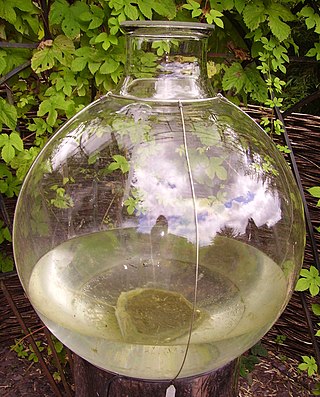
In climate science, a biosphere model, is used to model the biosphere of Earth, and can be coupled with atmospheric general circulation models (GCMs) for modelling the entire climate system. It has been suggested that terrestrial biosphere models (TBMs) are a more inclusive term than land surface models (LSMs). The representation of roots in TBMs, however, remains relatively crude. Particularly, the dynamic functions of roots and phylogenetic basis of water uptake remain largely absent in TBMs.

Bacterioplankton refers to the bacterial component of the plankton that drifts in the water column. The name comes from the Ancient Greek word πλανκτος, meaning "wanderer" or "drifter", and bacterium, a Latin term coined in the 19th century by Christian Gottfried Ehrenberg. They are found in both seawater and freshwater.
Berrien Moore III is the former director of the Institute for the Study of Earth, Oceans, and Space at the University of New Hampshire and the founding director of Climate Central. In June 2010, he accepted a set of linked positions at the University of Oklahoma: Vice President, Weather & Climate Programs, Director, National Weather Center, and Dean, College of Atmospheric and Geographic Sciences. He holds the Chesapeake Energy Corporation Chair in Climate Studies. Moore was a coordinating lead author of the final chapter of the Third Assessment Report of the Intergovernmental Panel on Climate Change (IPCC), an organisation that shared the 2007 Nobel Peace Prize. Among his other honors are the 2007 Dryden Lectureship in Research from the American Institute of Aeronautics and Astronautics and NASA Distinguished Public Service Medal. Moore holds a Ph.D. in Mathematics from the University of Virginia.

Climate change feedbacks are effects of global warming that amplify or diminish the effect of forces that initially cause the warming. Positive feedbacks enhance global warming while negative feedbacks weaken it. Feedbacks are important in the understanding of climate change because they play an important part in determining the sensitivity of the climate to warming forces. Climate forcings and feedbacks together determine how much and how fast the climate changes. Large positive feedbacks can lead to tipping points—abrupt or irreversible changes in the climate system—depending upon the rate and magnitude of the climate change.
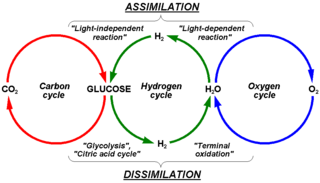
The carbon cycle is an essential part of life on Earth. About half the dry weight of most living organisms is carbon. It plays an important role in the structure, biochemistry, and nutrition of all living cells. Living biomass holds about 550 gigatons of carbon, most of which is made of terrestrial plants (wood), while some 1,200 gigatons of carbon are stored in the terrestrial biosphere as dead biomass.

David John Beerling FLSW is the Director of the Leverhulme Centre for Climate change mitigation and Sorby Professor of Natural Sciences in the Department of Animal and Plant Sciences (APS) at the University of Sheffield, UK. He is also Editor-in-Chief of the Royal Society journal Biology Letters.

The CO2 fertilization effect or carbon fertilization effect causes an increased rate of photosynthesis while limiting leaf transpiration in plants. Both processes result from increased levels of atmospheric carbon dioxide (CO2). The carbon fertilization effect varies depending on plant species, air and soil temperature, and availability of water and nutrients. Net primary productivity (NPP) might positively respond to the carbon fertilization effect. Although, evidence shows that enhanced rates of photosynthesis in plants due to CO2 fertilization do not directly enhance all plant growth, and thus carbon storage. The carbon fertilization effect has been reported to be the cause of 44% of gross primary productivity (GPP) increase since the 2000s. Earth System Models, Land System Models and Dynamic Global Vegetation Models are used to investigate and interpret vegetation trends related to increasing levels of atmospheric CO2. However, the ecosystem processes associated with the CO2 fertilization effect remain uncertain and therefore are challenging to model.

Marine biogeochemical cycles are biogeochemical cycles that occur within marine environments, that is, in the saltwater of seas or oceans or the brackish water of coastal estuaries. These biogeochemical cycles are the pathways chemical substances and elements move through within the marine environment. In addition, substances and elements can be imported into or exported from the marine environment. These imports and exports can occur as exchanges with the atmosphere above, the ocean floor below, or as runoff from the land.

FORMIND is an individual based forest gap model that is able to simulate the growth of species-rich forests. It was developed in the late 1990s to simulate forest dynamics of tropical forests.
Philippe Ciais is a researcher of the Laboratoire des Sciences du Climat et de l'Environnement (LSCE), the climate change research unit of the Institut Pierre Simon Laplace (IPSL). He is a physicist working on the global carbon cycle of planet Earth, climate change, ecology and geosciences.
Dominique Bachelet is a senior climate change scientist and associate professor in Oregon State University, with over 38 years of education and work in the fields of climate change, fire, and ecology. She has worked to make science more accessible, by creating web based resources with various scientific organizations. She returned to Oregon State University in 2017 but has continued her outreach work, getting valuable information to students, scientists, and scholars.

















